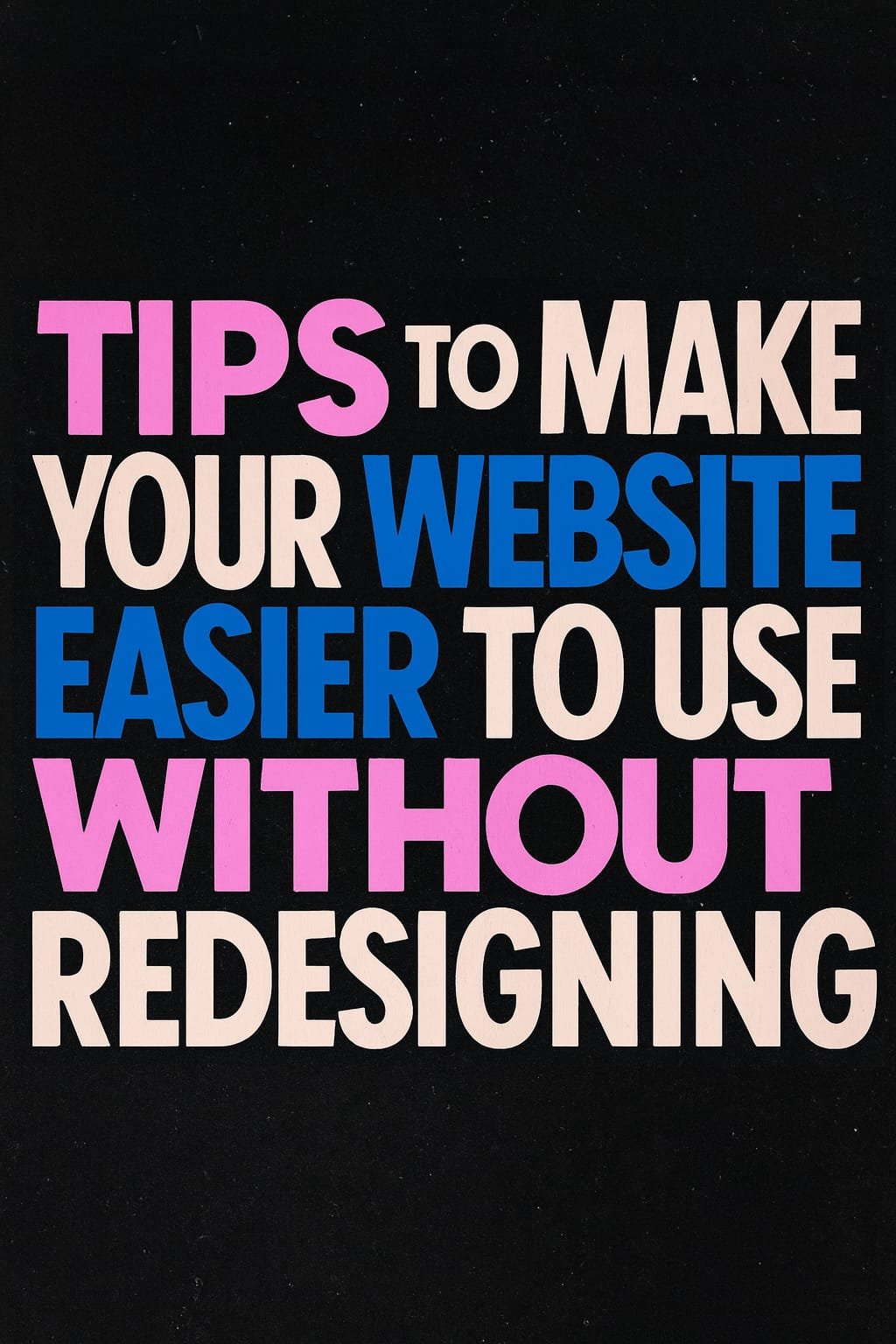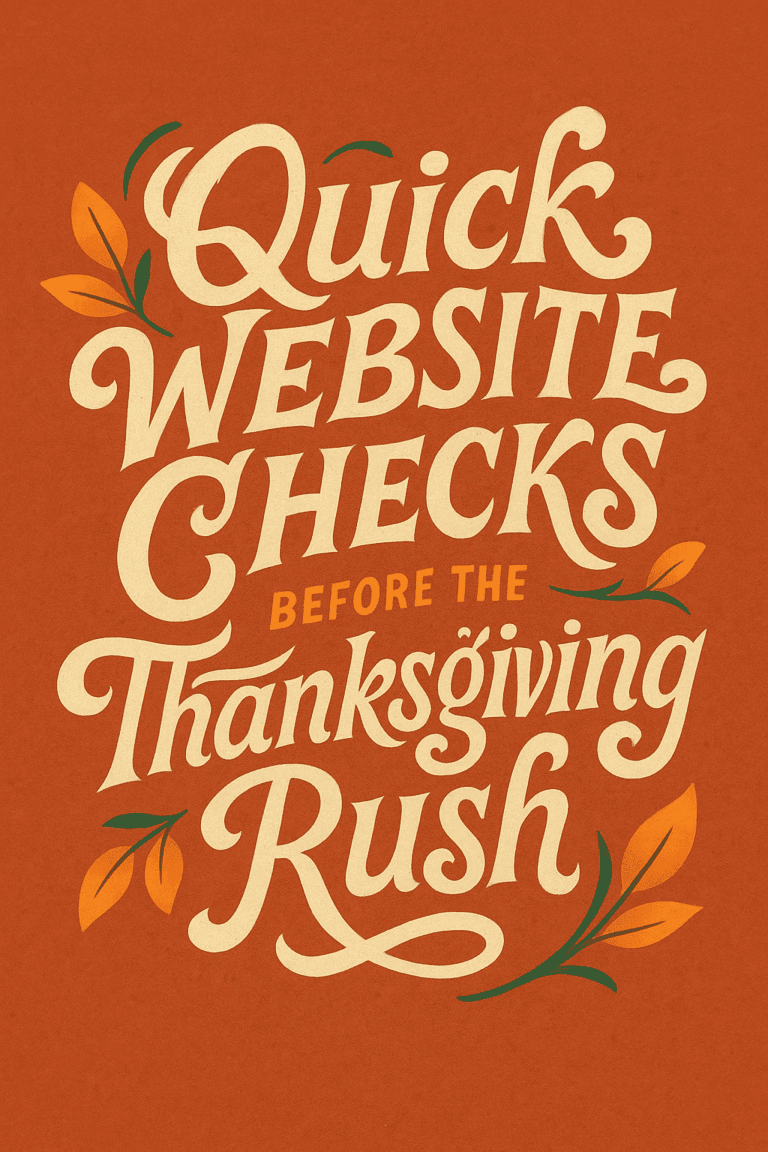
If you’re a business owner, the idea of completely redesigning your website might feel like a massive undertaking. You’ve invested time, money, and effort into your current site, and while it’s functional, you may have noticed it’s not delivering the smooth, engaging experience your visitors expect. Perhaps your bounce rates are higher than you’d like, or your conversions aren’t hitting the mark. The good news? You don’t need a complete overhaul to make a big difference. With targeted, practical changes, you can significantly improve your website’s usability, enhance customer satisfaction, and boost conversions—all without the high cost or hassle of a full redesign.
At Graticle Design, we’ve helped countless businesses transform their websites into user-friendly, conversion-driving powerhouses. In this in-depth guide, we’ll share actionable strategies to enhance your website’s usability. These tips are designed to be approachable, cost-effective, and optimized to improve your site’s performance on search engines like Google while keeping your visitors happy.
Let’s dive into practical, human-centered advice to better your website.
Why Website Usability Matters
Before we get into the specifics, let’s talk about why usability is so important. A website with great usability makes it easy for visitors to find what they need, navigate without frustration, and take the actions you want—whether that’s making a purchase, filling out a form, or contacting your team. A well-designed user experience can significantly increase conversion rates, while poor usability can drive visitors away. Plus, search engines like Google reward sites with fast load times, mobile-friendliness, and low bounce rates, meaning better usability can also improve your SEO performance.
By focusing on usability, you’re not just creating a better experience—you’re building trust, encouraging repeat visits, and driving measurable business results. Let’s explore how to achieve this with practical, actionable steps.
1. Simplify Your Navigation
Your website’s navigation is like a roadmap for your visitors. If it’s cluttered or confusing, they’ll get lost and leave. Simplifying your navigation is one of the fastest ways to improve usability without a major overhaul.
- Prioritize Essential Pages: Identify the core pages that drive your business goals—think Home, Products or Services, About Us, and Contact. Make these easy to find by placing them prominently in your navigation bar. Avoid burying critical pages in submenus where users might miss them.
- Clear and Concise Labels: Use straightforward, descriptive labels that instantly tell visitors what to expect. For example, “Shop Now” is clearer than “Browse Our Collection.” Avoid jargon or overly creative names that might confuse your audience.
- Limit Dropdown Menus: Dropdown menus can be helpful for organizing content, but too many layers can overwhelm users, especially on mobile devices where screen space is limited. Aim for no more than one level of dropdowns, and ensure they’re easy to tap or click.
Pro Tip: Use heatmapping tools to see where users click most often. This can help you rearrange your navigation to align with their natural behavior. A streamlined menu can reduce frustration and keep visitors on your site longer.
2. Improve Page Load Speed
Speed is critical today. Research shows that a significant percentage of users will abandon a site that takes more than a few seconds to load. Slow pages not only frustrate visitors but also hurt your search engine rankings, as Google prioritizes fast-loading sites. Here’s how to speed things up:
- Image Compression: Large image files are a common cause of slow load times. Use tools like TinyPNG or ImageOptim to compress images without sacrificing quality. Aim for file sizes under 100KB where possible.
- Enable Browser Caching: Caching stores elements of your site (like images and scripts) on a user’s device, so they load faster on return visits. Work with your web developer to enable this in your site’s settings.
- Reduce Plugins and Scripts: Extra plugins or scripts can slow your site down. Regularly audit your website to identify and remove unnecessary ones. For example, if you’re using a WordPress site, deactivate plugins you no longer need.
Pro Tip: Test your site’s speed using free tools like Google PageSpeed Insights or GTmetrix. These tools provide specific recommendations to improve load times, helping you prioritize quick wins.
3. Enhance Readability
Readable content keeps visitors engaged and makes your site feel professional. You don’t need a full redesign to improve readability—just a few strategic tweaks to your content formatting.
- Break Content into Sections: Long blocks of text can overwhelm readers. Use headings (like H2 and H3), bullet points, numbered lists, and short paragraphs to make your content easy to scan. Aim for paragraphs of 2–3 sentences.
- Adequate Color Contrast: Ensure your text stands out clearly against its background. For example, black text on a white background or white text on a dark background works well. Low contrast (like light gray on white) can cause eye strain and drive users away.
- Optimal Typography: Choose clean, professional fonts like Arial, Roboto, or Helvetica. Stick to a font size of at least 16px for body text to ensure readability on all devices, including mobile.
Pro Tip: Use tools like WebAIM’s Contrast Checker to verify that your text and background colors meet accessibility standards. This not only improves readability but also makes your site more inclusive.
4. Clearly Define Calls to Action (CTAs)
Your CTAs guide visitors toward the actions you want them to take, like signing up for a newsletter or making a purchase. Small tweaks can make your CTAs more effective.
- Use Contrasting Colors: Make CTA buttons stand out by using colors that contrast with the rest of your page. For example, a bright orange button on a blue background is more eye-catching than a gray button.
- Descriptive Phrasing: Use clear, action-oriented language like “Get Your Free Quote” or “Start Your Free Trial.” Avoid vague phrases like “Click Here” that don’t tell users what to expect.
- Strategic Placement: Place CTAs where users naturally look, such as at the top of a page, after a key section, or at the end of a blog post. Test different placements to see what works best.
Pro Tip: A/B test your CTAs using tools like Google Optimize to compare different colors, phrases, or placements. Even small changes can lead to significant improvements in click-through rates.
5. Optimize Forms for User Friendliness
Forms are often the gateway to conversions, whether you’re collecting leads, sign-ups, or inquiries. Complicated or confusing forms can scare users away, so keep them simple and intuitive.
- Minimal Fields: Only ask for the information you absolutely need. For example, if you’re offering a newsletter sign-up, you might only need an email address, not a full name and phone number.
- Clear Field Labels: Make it obvious what each field requires. For example, label a phone number field as “Phone Number (Optional)” if it’s not mandatory.
- Inline Validation: Provide real-time feedback as users fill out forms. For instance, if an email address is invalid, show a message like “Please enter a valid email” before they submit.
Pro Tip: Test your forms on multiple devices to ensure they’re easy to use on both desktop and mobile. A form that’s clunky on a smartphone can lead to abandoned submissions.
6. Improve Search Functionality
If your website has a lot of content, a robust search feature is essential to help users find what they’re looking for quickly.
- Visible Search Bar: Place your search bar in a prominent location, like the top-right corner of your site, where users expect to find it.
- Predictive Search: Add autocomplete or predictive search to suggest terms as users type, speeding up their search process.
- Advanced Filtering: Allow users to refine search results by categories, price ranges, or other relevant criteria, especially for e-commerce or content-heavy sites.
Pro Tip: Analyze search queries through your site’s analytics to see what users are looking for. This can help you identify gaps in your content or navigation.
7. Prioritize Mobile Optimization
With mobile devices accounting for a significant portion of web traffic, a mobile-friendly site is non-negotiable. You don’t need a full redesign to make your site mobile-ready—just some targeted adjustments.
- Responsive Design Tweaks: Ensure your site’s layout adapts seamlessly to different screen sizes. Test how your site looks on smartphones, tablets, and desktops.
- Clickable and Tappable Elements: Make buttons and links large enough to tap easily on a touchscreen. A good rule of thumb is a minimum size of 44×44 pixels.
- Simplified Mobile Navigation: Use collapsible menus (like hamburger menus) to save space on mobile screens while keeping navigation accessible.
Pro Tip: Use Google’s Mobile-Friendly Test to check how your site performs on mobile devices and get specific recommendations for improvement.
8. Refine Your Content
High-quality, relevant content is the backbone of a great user experience. Outdated or unclear content can confuse visitors and hurt your credibility.
- Regular Updates: Keep your content fresh by updating product descriptions, blog posts, or service pages regularly. This shows visitors your business is active and relevant.
- Simplified Language: Write in plain, easy-to-understand language that matches your audience’s needs. Avoid industry jargon unless your audience is highly specialized.
- Remove Outdated Information: Regularly review your site to eliminate old promotions, expired offers, or irrelevant content that could confuse users.
Pro Tip: Create a content calendar to schedule regular updates and ensure your site stays current. Even small updates can make a big difference.
9. Make Contact Information Easy to Find
Visitors should never struggle to get in touch with you. Clear, accessible contact information builds trust and encourages engagement.
- Visible Placement: Include contact details in your site’s header, footer, or a dedicated Contact page. A phone number or email link in the footer is a great start.
- Comprehensive Contact Page: Offer multiple ways to get in touch, such as email, phone, and a contact form. Clearly state expected response times to set expectations.
- Live Chat Integration: Adding a live chat feature can provide instant support, improving user satisfaction and reducing bounce rates.
Pro Tip: Test your contact methods regularly to ensure they work. For example, submit a test form or call your listed phone number to confirm everything is functioning.
10. Maintain Consistent Branding
Consistent branding reassures visitors they’re in the right place and strengthens your business’s identity.
- Visual Uniformity: Use the same colors, logos, and fonts across all pages. For example, if your logo is blue and white, don’t switch to red on some pages.
- Consistent Messaging: Align your website’s tone and messaging with your other marketing materials, like social media or email campaigns.
- Unified Design Elements: Ensure buttons, headers, and other design elements look cohesive across your site.
Pro Tip: Create a style guide for your website that outlines your brand’s colors, fonts, and tone. Share it with your team or web developer to maintain consistency.
11. Craft User-Friendly Error Messages
Error messages, like 404 pages or form submission errors, are inevitable. But poorly designed error messages can frustrate users and drive them away.
- Explain Clearly: Use simple language to explain what went wrong. For example, a 404 page could say, “Oops! We couldn’t find that page.”
- Suggest Helpful Actions: Provide next steps, like a link to your homepage or a search bar to help users find what they need.
- Keep It Friendly: Use a warm, professional tone to maintain trust, even when something goes wrong.
Pro Tip: Customize your 404 page to include a search bar, popular links, or a contact form to keep users engaged instead of leaving.
12. Conduct Routine Testing and Analysis
Ongoing testing ensures your site stays user-friendly as user behavior and technology evolve.
- Use Analytical Tools: Tools like Google Analytics can show you where users are dropping off or struggling. Look at metrics like bounce rate and time on page to identify issues.
- User Feedback: Collect feedback through surveys, user testing sessions, or feedback forms to understand what’s working and what’s not.
- A/B Testing: Test different versions of a page (like two different CTAs) to see which performs better.
Pro Tip: Set up a quarterly review process to analyze your site’s performance and make incremental improvements based on data and feedback.
13. Add FAQs and Resource Pages
FAQ and resource pages are a great way to answer common questions and reduce the need for direct inquiries, saving both you and your users time.
- Anticipate User Questions: Think about the most common questions your customers ask and create clear, concise answers.
- Organize Content Clearly: Group FAQs by topic (e.g., “Ordering,” “Returns”) and use headings or an accordion menu for easy navigation.
- Link to Resources: Include links to blog posts, guides, or videos that provide more in-depth information.
Pro Tip: Update your FAQ page regularly based on new questions you receive via email or live chat. This keeps it relevant and useful.
14. Implement Accessibility Best Practices
An accessible website ensures everyone, including people with disabilities, can use your site effectively. Plus, accessibility improvements often enhance the experience for all users.
- Alt Text for Images: Add descriptive alt text to all images to help screen readers describe them to visually impaired users.
- Keyboard Navigation: Ensure your site can be navigated using only a keyboard, which benefits users with motor disabilities.
- Accessible Colors: Use high-contrast colors and avoid color combinations that are hard for colorblind users to distinguish.
Pro Tip: Use tools like WAVE or axe to audit your site for accessibility issues and get actionable recommendations.
15. Create Internal Linking Strategies
Internal links guide users to related content, keeping them on your site longer and improving SEO.
- Relevant Links: Add links to related pages or blog posts within your content. For example, a product page could link to a related blog post or case study.
- Clear Anchor Text: Use descriptive link text, like “Learn more about our services,” instead of generic phrases like “Click here.”
- Logical Structure: Ensure links make sense in context and guide users naturally through your site.
Pro Tip: Use a sitemap to plan your internal linking structure and ensure all important pages are easily accessible.
16. Leverage Visual Hierarchy
A strong visual hierarchy helps users understand your content’s structure and prioritize what’s important.
- Use Headings Effectively: Use H1 for your main title, H2 for major sections, and H3 for subsections to create a clear hierarchy.
- Highlight Key Information: Use bold text, larger fonts, or different colors to draw attention to critical information like CTAs or key benefits.
- Whitespace: Incorporate plenty of whitespace to prevent your pages from feeling cluttered and overwhelming.
Pro Tip: Review your pages with a fresh eye to ensure the most important information stands out. If it’s hard to spot, tweak your design to make it clearer.
17. Optimize for SEO
Usability and SEO go hand in hand. A user-friendly site is more likely to rank well on Google, driving more traffic to your business.
- Keyword Research: Identify keywords your audience searches for and incorporate them naturally into your content, headings, and meta descriptions.
- Meta Tags: Write compelling meta titles and descriptions for each page to improve click-through rates from search results.
- Image Optimization: Use descriptive file names and alt text for images to boost SEO and accessibility.
Pro Tip: Use tools like Yoast SEO or SEMrush to analyze your site’s SEO performance and get tailored suggestions.
18. Build Trust with Social Proof
Trust signals like testimonials, reviews, or case studies can make your site feel more credible and encourage conversions.
- Add Testimonials: Include short, authentic customer testimonials on key pages like your homepage or product pages.
- Showcase Certifications: Display any relevant certifications, awards, or partnerships to build credibility.
- Highlight Numbers: Share stats like “Served 10,000+ Customers” or “20 Years in Business” to reinforce your authority.
Pro Tip: Place trust signals near CTAs to reassure users at the moment they’re deciding to take action.
Big Results Over Time
Improving your website’s usability doesn’t require a complete redesign. By implementing these targeted strategies—simplifying navigation, speeding up load times, refining content, and more—you can create a more engaging, user-friendly experience that keeps visitors coming back and boosts your conversions. Small, consistent improvements can lead to big results over time, helping your site perform better for both users and search engines.
Ready to take your website to the next level? Contact Graticle Design for a detailed usability analysis and personalized recommendations to enhance your online presence. Our team specializes in creating user-focused websites that drive results without breaking the bank. Let’s work together to make your website a powerful tool for your business.





